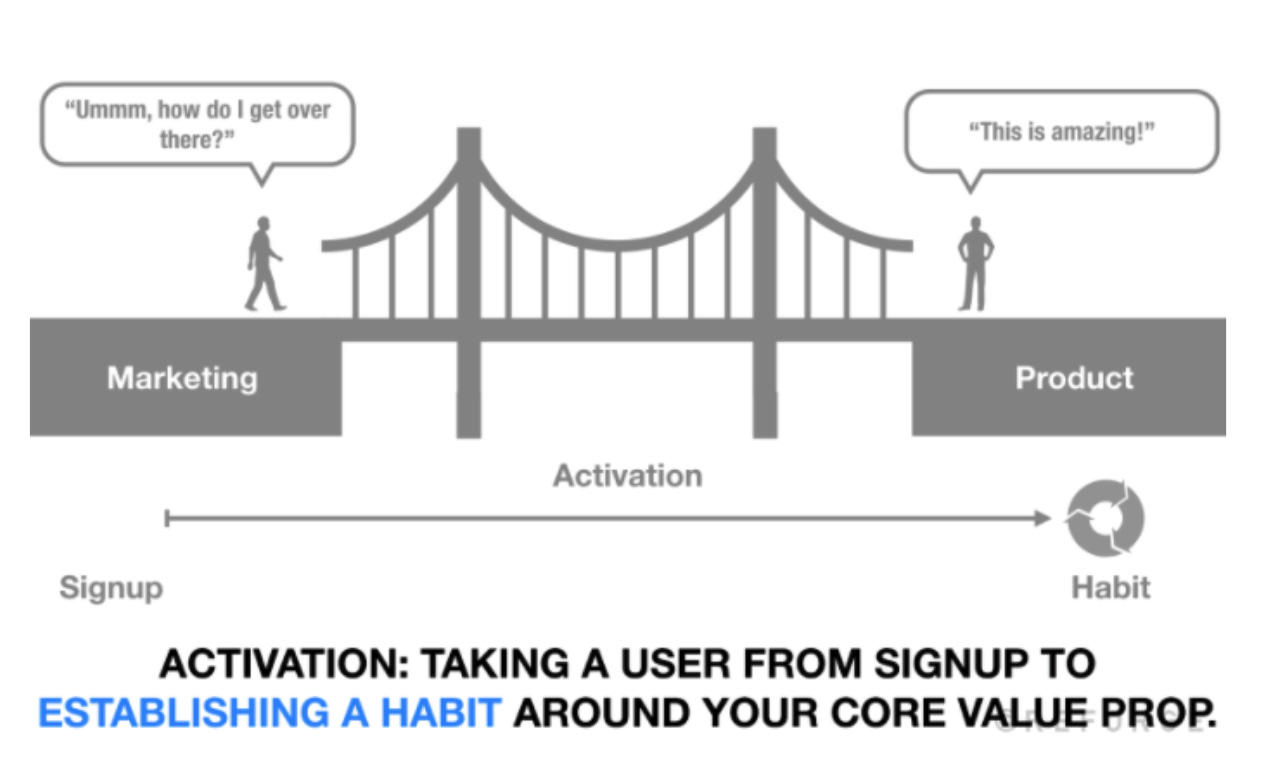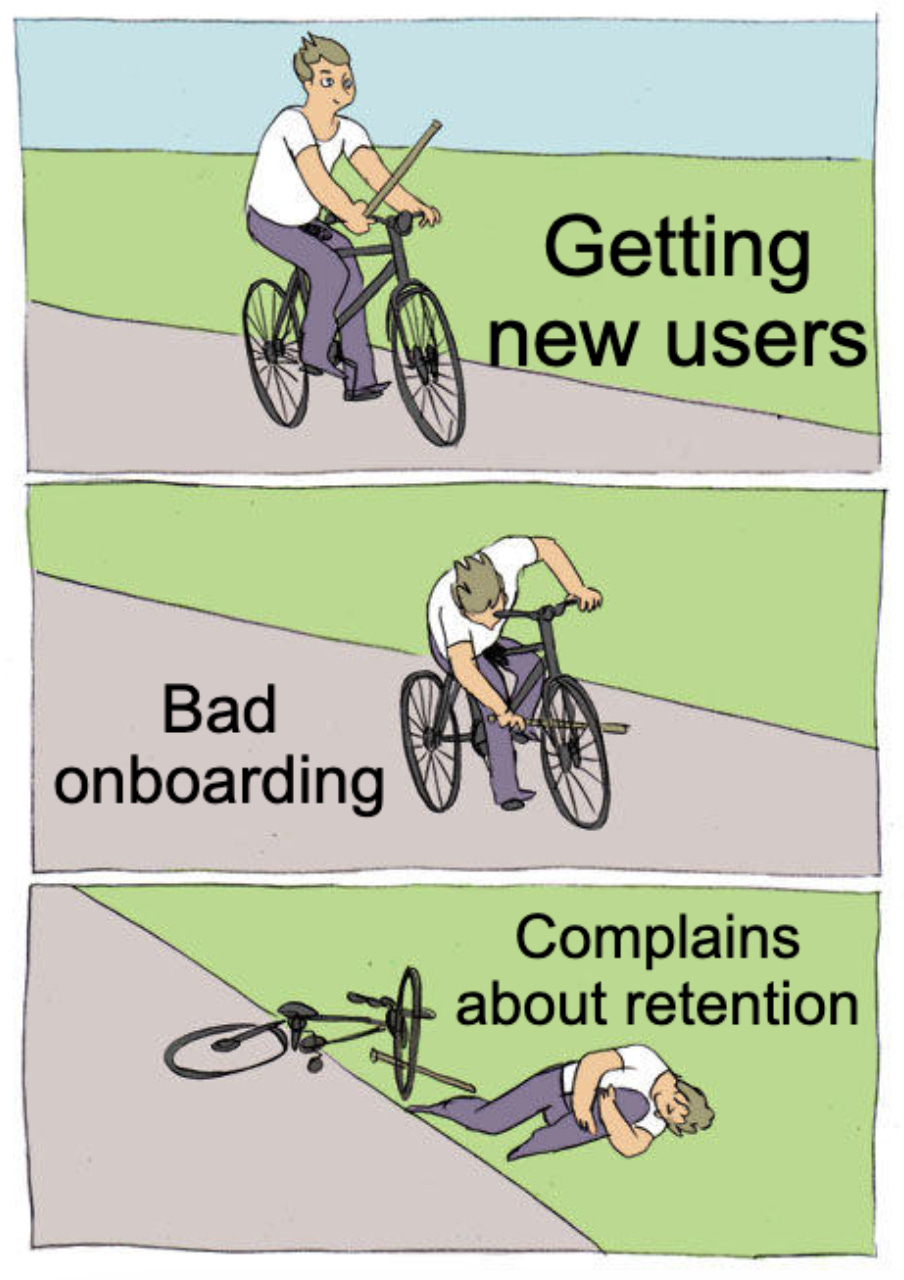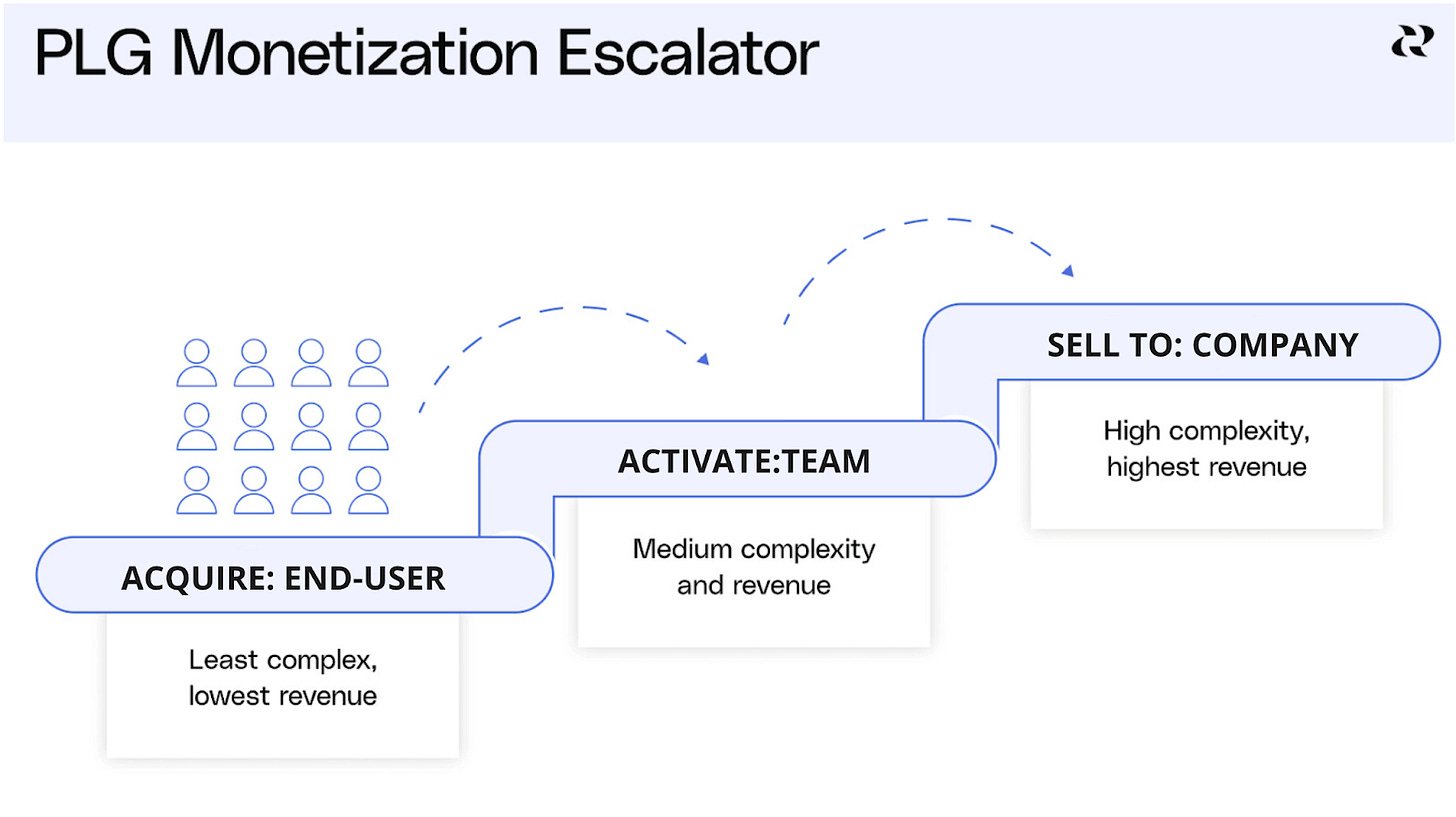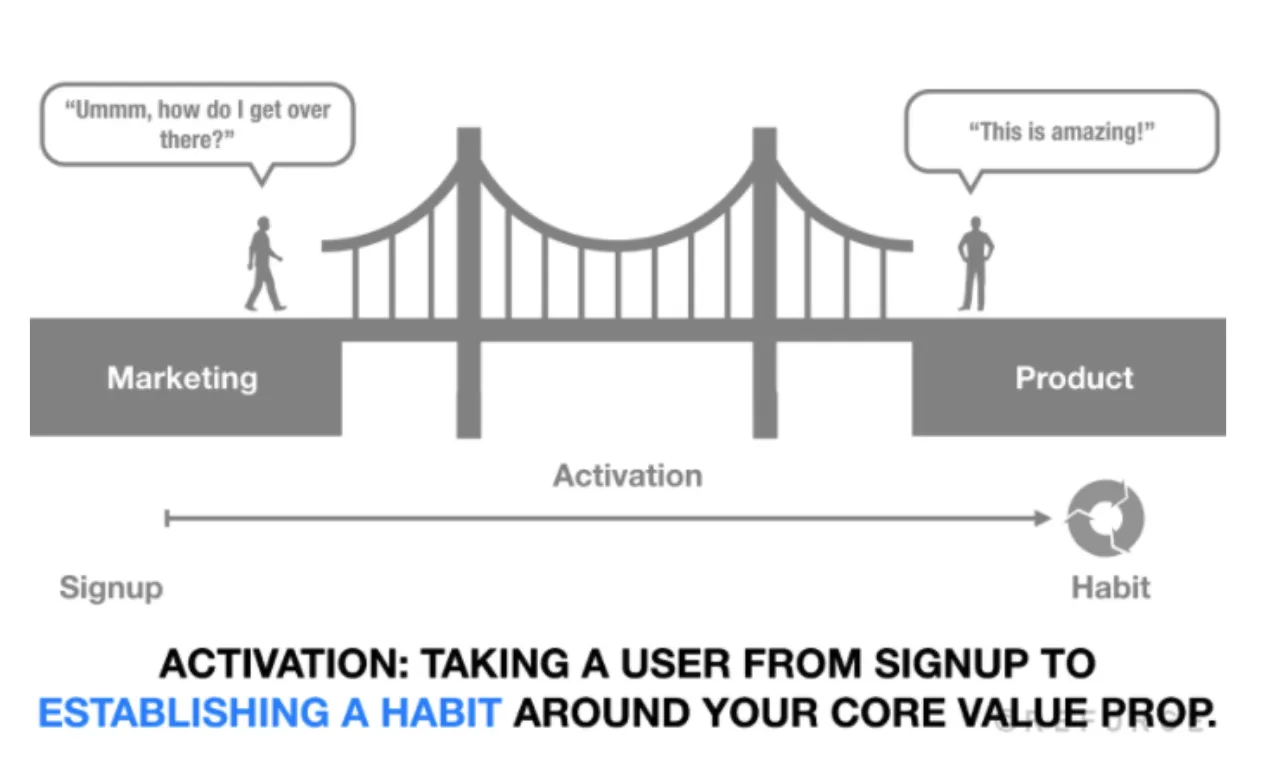by ELENA VERNA for Elena’s Growth Scoop
This is the last part of a mini-series I’ve done with the team at June:
- Part 1 reviewed the difference between product analytics in B2C and B2B
- Part 2 explored precisely how expansion happens in B2B
But for this final part, we need to talk about the foundational piece that makes B2B growth possible: activation.
Specifically: What activation IS and what it is NOT.
Activation: What it IS
I like Reforge’s definition best:
Activation is taking a user from signing up to establishing a habit around your core value prop.

In practice, product activation consists of 3 steps: setup, aha, and habit loop.
Setup
Setup phase involves the user performing the necessary actions to get to the core value prop of the product. Think about a person going on a walk: The setup consists of getting dressed, getting out the door, and starting your walk.
Examples of the setup:
- SurveyMonkey: Create a survey, add questions, pick response collection method
- Miro: Create the board, add elements to the board, invite somebody/share board
- Dropbox: Add/upload inventory to the account
The user is ready—but they haven’t received the value. Yet.
TIP! Many companies excel at innovating in setup and mistakenly want to count setup as their value delivery, or aha moment. Don’t fall in this trap. Setup is only the first step, no matter how innovative it is.
Aha
The aha moment is when the user has received and realized the core value your product has to offer. Going back to the walk analogy, this is when you finish your walk and feel great about yourself.
Examples of aha moments across companies where I’ve worked:
- SurveyMonkey: Receiving and viewing five or more responses
- Miro: Collaborating on the board with two or more people
- Dropbox: Editing, viewing, or inviting someone else to a shared file/folder
TIP! The aha moment should be measurable in a quantitative way. Plus, your aha generally cannot be reflected by a simple vanity metric. So, for example, this cannot be just a ‘login’ or ‘view’ action. Just because you log in or view something, doesn’t mean you’ve received value.
Habit loop
The aha moment is powerful, but still only a one-off experience for your users. For activation to be complete, users need to show that they’ve understood the reward from the value received and want to receive it again. This step is observed through the first habit formation by customers establishing repeated behaviors within the desired frequency: daily, weekly, monthly, quarterly, etc. Creating this habit is often referred to as forming a “habit loop.” In our taking a walk example, this would be starting to do weekly walks.
More examples:
- SurveyMonkey: Receiving and viewing responses on a monthly basis
- Miro: A team having weekly collaborative sessions on the board
- Dropbox: Editing, viewing, or inviting to a shared file/folder on weekly basis
(Want to see more interesting examples? Checkout Reforge Artifacts)
Habit often stems from the repetition of an initial aha moment. While sometimes companies might incorporate additional user actions into the habit loop, the fundamental idea remains the same. The crucial takeaway is that completing the first habit loop should be a strong indicator of future user retention and monetization.
TIP! Many define “daily,” “weekly,” and “monthly” as “active yesterday,” “active last week,” and “active last month,” respectively. But that’s not observing frequency. That’s merely measuring another one-off event. “Active last week” metric could have had a customer who was active every single day, for the first time in 3 years, or who is active on a weekly basis. The key is to figure out your product’s ideal frequency of use, and then build that into your loop definition.
For example:
- Daily: active 3 out of 5 days/week over last 2 weeks
- Weekly: active 3 out of last 4 weeks
- Monthly: active 3 out of last 4 months
Activation: What it is NOT

Activation is not… Engagement
Once activation is complete, you can focus on measuring engagement. But don’t make this shift prematurely—efforts to get users into an initial habit loop are different from ongoing engagement. Activation is all about education and onboarding, whereas engagement is about:
- Integrating deeper into existing environmental activity triggers: being top of mind where intent for your product is created.
- Manufacturing new triggers for engagement: creating reasons for engaging with your product.
- Creating more intensity within each activity movement: increasing time spent in the platform if it benefits value delivery. Interestingly, this is a must-have strategy for social, but an anti-metric for productivity tools.
- Deepening feature engagement.
- Layering use cases.
B2B: User activation is not… Account activation
In B2B, the end goal is to sell to another company. Yet in product-led growth, you start with user—you’re focused on the end-user, often in a free state. So how do you bridge between generating successful end-user engagement and selling to a company?
Answer: Create an escalator (framework from Reforge PLG Course)

Although you acquire users, you need to activate teams in order to be able to sell to companies. This means an activation journey across setup, aha, and habit loop should be thought through on the team level in order to trigger the first step of the escalator to a company level value.
What happens if you don’t?
Story time!
When I was at SurveyMonkey, we were deeply committed to delivering value to prosumers. We scrutinized everything from an end-user perspective, focusing on survey creation and response collection. As we sought to expand into the upper market, our forecasts centered around our potential to market enterprise plans to the most engaged mid-market and enterprise brands. At times, within a single logo, we often observed as many as 800+ paid and over 1,000 free active accounts. This seemed like a solid foundation to seal an enterprise deal. However, our sales initiatives repeatedly fell short. We eventually understood that a large number of individual users doesn’t guarantee successful bottom-up selling. These end-users, satisfied with their siloed account, saw no advantage in expanding their account access. Some even resisted the enterprise plan as it introduced data retention, user roles, SSO, and other enterprise-centric features that detracted from their experience rather than making it better.
Conversely, during my tenure at Miro, our primary goal was to foster network effects within accounts. Yes, individual usage occurred, but we didn’t consider an account activated unless there was collaboration. Regardless of how often they engaged, if they hadn’t collaborated with someone on the board, we viewed them as being stuck in the setup stage. Our focus was on promoting collaborative interactions and growing user numbers within existing teams. For instance, when a user signed up and we identified that their email domain was already affiliated with a team, we nudged them to join that team rather than starting a solitary account.
At Miro, we built teams that thrived on collaboration. They saw the value in more members joining since it enhanced their collaborative capabilities. This approach boosted bottom-up, end-user demand for enterprise solutions – where end users cornered enterprise buyers to purchase more Miro.
What does this mean in practice?
Setup, aha, and/or habit loop have to incorporate *distribution* within the account. One way to do this is: adding “Invite another user” as a mandatory setup action. Or structuring the aha moment around 2 or more people engaging in additional jobs to be done, say reviewing or viewing. Whatever it is, make sure that the activation journey activates a team on various jobs to be done (creation, editing, or viewing), and not just individual value, and lays down the foundation to company level value unlock.
B2B Activation should not… Always be self-serve
Companies that emphasize product-led growth often lean towards self-serve activation as the sole method for account activation. However, this approach can be limiting in certain scenarios:
1. Enterprise Buyers: When enterprise buyer signs up, they might struggle to grasp the full value your company offers solely through a self-serve activation. They often require a more tailored experience to understand the broader organizational benefits.
2. Complex Use Cases: Situations like data migration can’t always be addressed through a self-serve flow due to their intricate nature. Such cases often require specialized assistance.
3. High-Value Segments: If someone influential or from a significant organization (e.g., Google) signs up, it might be beneficial to provide them with a more personalized experience, given the potential for higher monetization.
It’s essential to recognize that product-led experiences excel at addressing frequent, simple issues. However, deviations from these straightforward problems might necessitate the involvement of Support, Sales, Sales Engineering, or Sales.
Consider using multiple touch points with your users to activate them:
- Tech touch (In-app tours, lifecycle emails): Works well when small gaps should be closed during the session.
- Human touch (Onboarding call, In-app chat): Does wonders in creating step function change in users’ habits. Ex: Superhuman nailed this.
- Education (FAQ, Help center, Academy): Some people learn by doing, others by reading. This is the right place for them.
What does this mean in practice?
Start with profiling during onboarding to understand who will benefit from additional touch point.
It’s an old myth that you should oversimplify your onboarding to reach high activation rates. In reality, only super low intent customers that would have never activated in the first place drop off (3 screen/9 question onboarding has no more than a 10% drop-off rate and no impact on number of customers reaching habit loop).
Customers are willing to tell you about themselves during onboarding – so ask away!
Here are my favorite attributes to ask about:

Alternatively, you can get quick and seamless user info by using June’s qualification bot, or a dedicated provider (Clearbit, FullContact) – but triple check data quality.
B2B Activation does not… Start over for every new user
Multiple employees may sign up for your product and have complementary roles.
If that’s the case, then a combination of their actions will lead the account to activate. B2B SaaS companies run a relay race, not a solo sprint.
The sooner you understand who plays what role, the faster you’ll be able to deliver the right “what” to the right person.
Two common users in B2B:
- Creator vs. Readers: One leverages the solution to create value, the other only consumes it. Ex: Airtable orients around individuals who build out bases and manage the data, which is often a very different use-case from those who simply view the tables or dashboards.
- Operator vs. Engineers: The engineer does the technical implementation, then never comes back. The operator then uses it on a regular basis. Ex: Implementing Intercom generally requires an engineer, but an operator is the long-term owner and user.
Don’t assume that each new sign-up needs to create a new account.
Do email domain matching and surface an option for a new sign-up to join an existing org (if possible). Letting customers discover existing teams in their company already using the product will deliver the biggest engagement boost to that user (better together!).
Final thoughts
For any product, activation is a vital step: It’s the bridge that covers the gap between initial acquisition and healthy, ongoing engagement.
Want some deeper insights into nailing this crucial part of the user journey?
- June has built The Product Activation Playbook to walk you through every step of the process (it’s free!)
- Reforge always has amazing information in their courses. Growth Series is excellent or newly launched Reforge PLG Course (created by yours truly!).
Thanks for reading!
